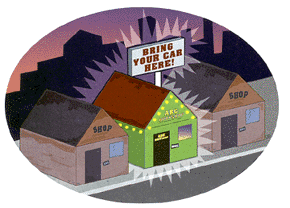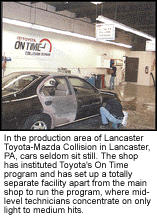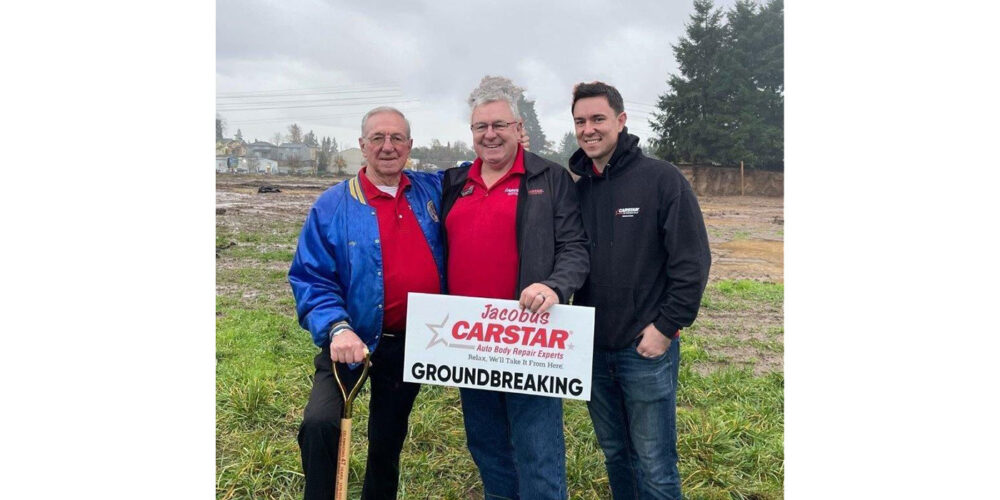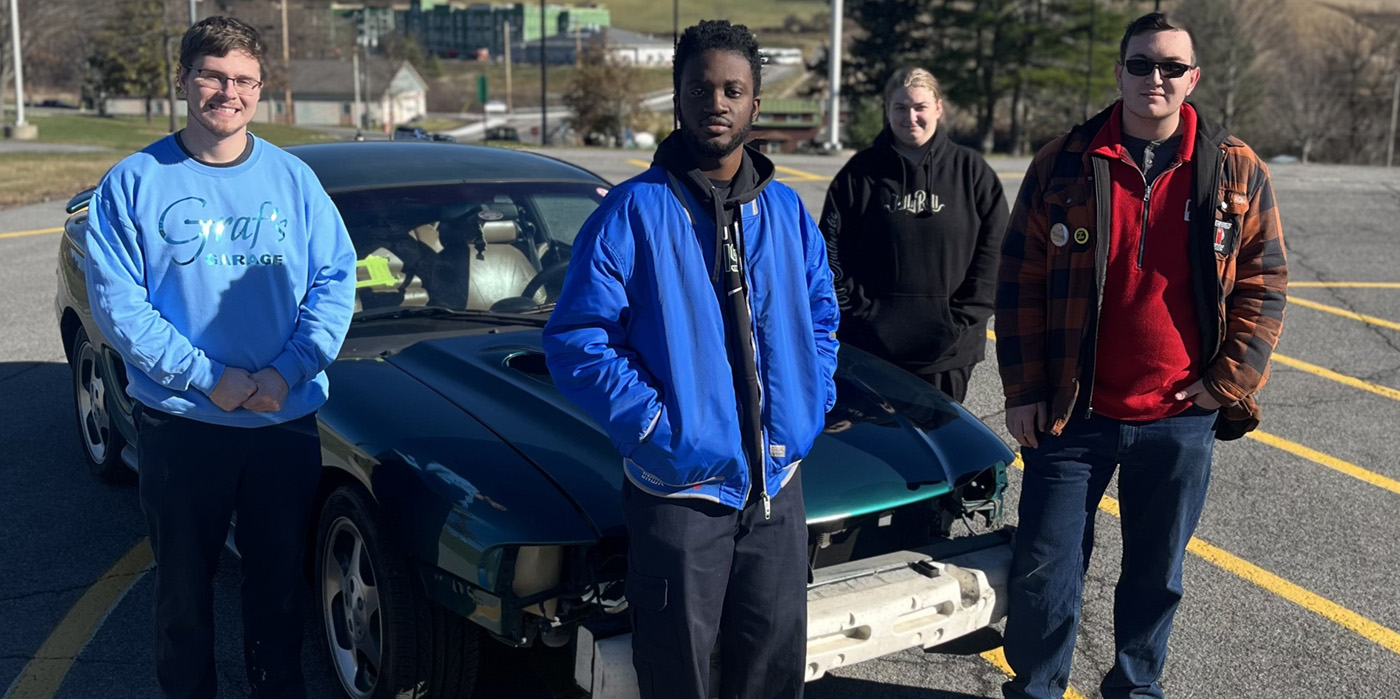– John Thompson, shop manager,
 “How can I make a higher profit margin in the body shop as the insurance companies are paying less and less?”
“How can I make a higher profit margin in the body shop as the insurance companies are paying less and less?”
Fix Auto Mall, Auburn, N.Y.
There are only two ways to increase gross profit on a given sales volume. The first is to increase your bottom line, i.e. charge more. The difficulty in accomplishing this is well known in a market that some would say is dominated by third-party payers. This only leaves a reduction in the cost of sales as a means of generating greater profits.
Conventional wisdom will tell you that it’s necessary to cozy up to insurers as a way of filling your shop with late-model wrecks. Industry pundits whose words and advice fill the pages of this very magazine will tell you that in order to do business with insurance companies, you have to do and be certain things. This usually means limiting prices, making concessions and offering discounts in exchange for a promise of increased volume. If this is the route you choose, the opportunities to increase profits by way of increased prices are limited (practically non-existent actually).
Regardless of the route you’ve chosen, when you’re working with a finite number of dollars – which probably isn’t destined to change much considering of all the new efficiencies in the market and tough competitors – you have to constantly weed your garden. Weeds grow in areas of your business that go uncultivated. Examine your business from different angles and there’s no telling where you’ll find waste. You also need to set your shop apart from the rest. Shops that don’t differentiate themselves from other shops in the market may not find themselves in the market a few years from now.
Use Your Time and Space Wisely
Let me touch on the much-touted notion of cycle time. But instead of viewing cycle time reduction in terms of pleasing the insurance genie, let’s look at cycle time in terms of what it can do for body shop profits. They say efficiency is its own reward, and cycle time reduction is all about enhancing efficiency.
For years, analysts have spoken of the inefficiencies inherent to a body shop operation. The processes in which the work on a car is started, stalled, restarted and stalled while waiting for parts, approvals, re-inspections and access to repair equipment can severely sap the profit from jobs. Anything a shop operator can do to eliminate some or all of these delays will decrease turn around and, at the same time, increase gross profit.
If you were to allocate a fixed cost to each job for the space it takes up in your shop’s production area, it’s logical to assume that a car that just sits all day is losing money. Reducing that inactivity by any means necessary will result in a corresponding increase in profit.
Several years ago, a feature ran in a trade publication about a man named Eddie Garneau, who was known for the Garneau Method of body shop management. Essentially, the Garneau Method involved securing all the parts for a job, ascertaining the parts were the correct ones and performing a thorough pre-repair damage analysis before the job was started. In this way, the incidence of unforeseen damage, supplements and the accompanying delays are all but eliminated.
Even though a job may take just as long (or even longer) to get back in the hands of a customer using this method of shop management, the time a car is in production is greatly reduced. This is a version of cycle time reduction, but not in the sense that an insurance company would benefit. The chance of it taking longer using this method is likely because shop management will wait for a window on a frame rack (for example) in which it can be processed on their timetable. This can mean the car will sit there – with all of the rest of the requirements in place – waiting and possibly holding up the job.
Using the Garneau Method, an uninterrupted flow of technician labor can be applied to the car in such a way that no floor space and no time is wasted. Once the tech starts the job, the flow never stops. Jobs aren’t stalled for any foreseeable reason, so they move unimpeded through the production system. No surprises. No delays. While this can be relatively easy to do with small jobs, it takes a much greater degree of organization and follow through in the front end.
In streamlining a shop’s operation, the burden to expedite repairs falls on the office staff and managers. This shouldn’t be confused with a shop foreman standing over a technician with a bullwhip, yelling, “Faster, faster! You’re holding up production!”
To illustrate how it should work, let’s take a look at the body shop of Lancaster Toyota-Mazda, a multi-line dealership shop in Lancaster, Pa., that I recently visited and that’s instituted the new Toyota On Time Collision Repair System (OTCR). In fact, they set up a totally separate facility apart from the main shop where the OTCR operates. There, mid-skilled technicians concentrate on light to medium hits. All parts are secured, the cars are thoroughly examined and the insurance claims are settled in their entirety beforehand. In this way, turnaround is greatly reduced. Sounds great but …

Body shop manager Jan Jurel says technicians in the main collision center were somewhat resentful because all the “gravy” jobs were siphoned off the top, leaving them with the train wrecks. While this may be true, the gross profit margins in the OTCR department were way up from what they would’ve been had the light hits been funneled through the main shop.
Management addressed resentment in the main shop by implementing some aspects of the plan there, making a better environment for them. Also, the OTCR techs are paid less per flat-rate hour, so the main shop’s techs will always make more. This plan, however, is subject to refinement, and they did still lose a few technicians.
You Can’t Be Everything to Everyone. Specialize.
One of my favorite shop owners always tells me that every day is a new adventure for him. From the perspective of the technician on the shop floor, that’s indeed the case due to the dizzying array of new models, designs and configurations of today’s cars.
How does this door panel come off? How does this dashboard attach to the cowl? Where are the SRS sensors on this car? How will this color look outside? How do I best duplicate the coating on the fender apron? An experienced tech can, in most cases, work through these challenges without losing too much in the way of productivity. However, given the changes and advancements we’re seeing in today’s cars, you can’t help but go careening off the high side of the learning curve from time to time.
Most body shops, in their efforts to keep their bays full, take on all comers. They try to be everything to everyone – a goal that’s as impossible as it is unimaginable to any consumer.
Customers who just paid $25,000 for a new Camry don’t want to hear that you can be everything to everyone. What they do want to hear is why there’s no shop in the area better suited to repair their car than yours. Once they understand this to be the case, you’ll find that they’ll be content to wait in line so you can repair their car on your timetable.
A benefit to specialization is your shop’s market position. Consumer perception of dealer body shops being better equipped and trained to repair their cars is well known. While some of this belief may not be founded in fact, the truth of the matter is that consumers lean toward dealer shops (specialists) during their car’s honeymoon period when primary warranties still exist.
It’s this belief that gives new car dealers’ body shops a captive market, despite the fact that in many cases they’re no more qualified than anyone else in town. Most collision repair customers with new cars rely on the selling dealer’s shop or their recommendations. And even if the repair involves little more than changing a fender and a bumper cover, they want a specialist doing the job to their rather pedestrian Corolla. And when they see nothing but Camrys, 4Runners and Lexuses in your lot, they’ll relax.
Imagine the advantages of working on the same cars every day. Boring? Maybe. But boring is good. Eliminate surprises (adventures, as my friend likes to call them). You can’t help but become adept when assembling and disassembling specific models. Mazdas, Toyotas, Hondas, Nissans and VW products are particularly good specialty cars – not because they need a specialist, but because they’re so much easier to repair than other makes. This is only true in terms of ease of replacement of assemblies. But with respect to OE parts sales and support, Toyota is arguably the best.
Re-Examining Dealer Alliances
Specialization doesn’t mean whoring yourself out to dealers. The traditional dealer alliances were always vertical in nature. All customers went through the dealership and then down to the body shop, which has always paid some sort of tribute in the transaction. Whether it was the shop’s willingness to do used cars and warranty work at cost plus arrangements or the actual cash discounts and kickbacks paid to a service manager, a shop was essentially buying dealer work. The cost, as is almost always the case, eventually becomes too much, and the dealer contract goes to another shop.
True specialization breaks the vertical hold in that a specialist independently accesses the market for, let’s say, Toyota buyers. How is this done, you ask? You can electronically sort customer lists from oil change franchises, parking garages and police records. All for a price, of course. Send out printed brochures to those owners in the zip codes you want to service. In that literature, make it clear that while you service only Toyota cars, you welcome all owners regardless of insurance affiliation, creed or baseball team. By doing this, you circumvent insurance referrals by getting to customers first. It’s well-known that insurance steering works best when collision repair customers don’t have a preconceived preference of body shops.
Then there are the usual approaches with signage, direct mail, radio and Web advertising. Be sure to stress your specialties here, yet ever mindful of trademark and copyright usage. Make it clear that your shop has in no way been endorsed by a particular manufacturer – but, at the same time, convey the idea that you’ve, for example, paid to have your technicians flown to the Toyota Technical Training Center in Torrance, Calif.
In your market positioning, it’s essential to let consumers know that no insurance company would deprive them of the best in Toyota repair work, particularly when you charge competitive rates. Make sure they know it costs your customers no more to bring their Toyota to your shop. Guaranteed.
Other Areas to Cut Costs
If you go the specialization route, other cost-savings areas are worthy of note.
When your work is comprised of 75 percent of the same make of car, you can drastically reduce your shop’s clip and hardware inventory. As you narrow your shop’s specialties and reduce the variety of cars, you shrink the number of single-use fasteners, along with that department’s expenses. Coordinate this with your shop’s parts manager or person responsible for clips and hardware.
The same things can be said for the paint department. With your painters seeing the same colors day in and day out, they know the problems – and the solutions. They’ll recognize a variance when they see one, and they’ll select the right formula without the trial and error they often have to go through to nail one down. Less colors also means less tints to stock, so you’ll see a savings in your paint inventory.
And while we’re on the subject of paint, no cost-cutting analysis would be complete without a discussion of the more recent trend to hit the market: generic paint. Many shops are now buying off-brand paint. The value-added services you find in the big names may be worth the extra bucks and you may have had consistent results with the name-brand paints, but the generic material you shoot is likely to come from the same vats and/or manufacturers. Check with your jobber and reps from your present paint supplier.
Lastly, look at your parts purchases. It’s sometimes possible to squeeze a few more points out of a dealer supplier when payment terms are set up. While writing a check every time parts are delivered may be a nuisance, the cash discounts offered by suppliers is often worth the time it takes. Also take a look at group buying. Many body shop associations pool their members’ purchases to gain a better price schedule from suppliers.
Different Is Good
While this industry is unlike that of most retailers, it’s also similar in that a shop that doesn’t stand out is destined to be plowed under if it doesn’t remain profitable. If a company like K-Mart can succumb to hard competition and be forced into bankruptcy, then a wise collision repair shop owner should sit up and take notice. K-Mart failed because it was unable to set itself apart in the face of competition from strong players like Target and Wal-Mart. As consolidators and corporate types move into the body shop business, marginal players in our industry will also get squeezed from the market. Securing your business’ profitability and position in the market is more important today than it ever was.
Writer Charlie Barone has been working in and around the body shop business for the last 27 years, having owned and managed several collision repair shops. He’s an ASE Master Certified technician, a licensed damage appraiser and has been writing technical, management and opinion pieces since 1993. Barone can be reached via e-mail at [email protected].













